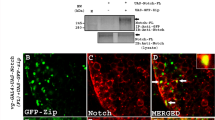Abstract
Dd-STATa is a functional Dictyostelium homologue of metazoan STAT (signal transducers and activators of transcription) proteins, which is activated by cAMP and is thereby translocated into the nuclei of anterior tip cells of the prestalk region of the slug. By using in situ hybridization analyses, we found that the SLF308 cDNA clone, which contains the ecmF gene that encodes a putative extracellular matrix protein and is expressed in the anterior tip cells, was greatly down-regulated in the Dd-STATa-null mutant. Disruption of the ecmF gene, however, resulted in almost no phenotypic change. The absence of any obvious mutant phenotype in the ecmF-null mutant could be due to a redundancy of similar genes. In fact, a search of the Dictyostelium whole genome database demonstrates the existence of an additional 16 homologues, all of which contain a cellulose-binding module. Among these homologues, four genes show Dd-STATa-dependent expression, while the others are Dd-STATa-independent. We discuss the potential role of Dd-STATa in morphogenesis via its effect on the interaction between cellulose and these extracellular matrix family proteins.







Similar content being viewed by others
References
Abe T, Langenick J, Williams JG (2003) Rapid generation of gene disruption constructs by in vitro transposition and identification of a Dictyostelium protein kinase that regulates its rate of growth and development. Nucleic Acids Res 31:e107
Araki T, Gamper M, Early A, Fukuzawa M, Abe T, Kawata T, Kim E, Firtel RA, Williams JG (1998) Developmentally and spatially regulated activation of a Dictyostelium STAT protein by a serpentine receptor. EMBO J 17:4018–4028
Araki T, Tsujioka M, Abe T, Fukuzawa M, Meima M, Schaap P, Morio T, Urushihara H, Katoh M, Maeda M, Tanaka Y, Takeuchi I, Williams JG (2003) A STAT-regulated, stress-induced signaling pathway in Dictyostelium. J Cell Sci 116:2907–2915
Combet C, Blanchet C, Geourjon C, Deleage G (2000) NPS@: network protein sequence analysis. Trends Biochem Sci 25:147–150
Corpet F (1988) Multiple sequence alignment with hierarchical clustering. Nucleic Acids Res 16:10881–10890
Dormann D, Abe T, Weijer CJ, Williams JG (2001) Inducible nuclear translocation of a STAT protein in Dictyostelium prespore cells: implications for morphogenesis and cell-type regulation. Development 128:1081–1088
Escalante R, Loomis WF (1995) Whole-mount in situ hybridization of cell-type-specific mRNAs in Dictyostelium. Dev Biol 43:262–266
Fukuzawa M, Williams JG (2000) Analysis of the promoter of the cudA gene reveals novel mechanisms of Dictyostelium cell type differentiation. Development 127:2705–2713
Fukuzawa M, Araki T, Adrian I, Williams JG (2001) Tyrosine phosphorylation-independent nuclear translocation of a Dictyostelium STAT in response to DIF signaling. Mol Cell 7:779–788
Hou SX, Zhen Z, Chen X, Perrimon N (2002) The JAK/STAT pathway in model organisms: emerging roles in cell movement. Dev Cell 3:765–778
Kawata T, Shevchenko A, Fukuzawa M, Jermyn KA, Totty NF, Zhukovskaya NV, Sterling AE, Mann M, Williams JG (1997) SH2 signaling in a lower eukaryote: a STAT protein that regulates stalk cell differentiation in Dictyostelium. Cell 89:909–916
Maeda M, Kuwayama H, Yokoyama M, Nishio K, Morio T, Urushihara H, Katho M, Tanaka Y, Saito T, Ochiai H, Takemoto K, Yasukawa H, Takeuchi I (2000) Developmental changes in the spatial expression of genes involved in myosin function in Dictyostelium. Dev Biol 223:114–119
Maeda M, Sakamoto H, Maruo T, Ogihara S, Iranfar N, Fuller D, Morio T, Urushihara H, Tanaka Y, Loomis WF (2003) Changing patterns of gene expression in prestalk cell subtypes of Dictyostelium recognised by in situ hybridisation with genes from microarray analyses. Eukaryot Cell 2:627–637
Mohanty S, Jermyn KA, Early A, Kawata T, Aubry L, Ceccarelli A, Schaap P, Williams, JG, Firtel, RA (1999) Evidence that the Dictyostelium Dd-STATa protein is a repressor that regulates commitment to stalk cell differentiation and is also required for efficient chemotaxis. Development 126:3391–3405
Morio T, Urushihara H, Saito T, Ugawa Y, Mizuno H, Yoshida M, Yoshino R, Mitra BN, Pi M, Sato T, Takemoto K, Yasukawa H, Williams J, Maeda M, Takeuchi I, Ochiai H, Tanaka Y (1998) The Dictyostelium developmental cDNA project: generation and analysis of expressed sequence tags from the first-finger stage of development. DNA Res 5:335–340
O’Shea JJ, Gadina M, Schreiber RD (2002) Cytokine signaling in 2002: new surprises in the Jak/Stat pathway. Cell 109:S121–S131
Traynor D, Kessin R, Williams JG (1992) Chemotactic sorting to cAMP in the multicellular stages of Dictyostelium development. Proc Natl Acad Sci USA 89:8303–8307
Wang Y, Slade M, Gooley AA, Atwell BJ, Williams KL (2001) Cellulose-binding modules from extracellular matrix proteins of Dictyostelium discoideum stalk and sheath. Eur J Biochem 268:4334–4345
Zhukovskaya NV, Fukuzawa M, Tsujioka M, Jermyn KA, Kawata T, Abe T, Zvelebil M, Williams JG (2004) Dd-STATb, a Dictyostelium STAT protein with highly aberrant SH2 domain, functions as a regulator of gene expression during growth and early development. Development 131:447–458
Acknowledgements
This work was partly supported by The Naito Foundation, The Sumitomo Foundation, The Yamada Foundation and Faculty of Science Special Grant for Promoting Scientific Research at Toho University to T. Kawata, the Future of the Japan Society for the Promotion of Science to M. Maeda, as a member of the Kuhara’s Project (JSPS-RFTF00L01412), and H. Urushihara (JSPS-RFTF96L00105), and by a Grant-in-Aid for Scientific Research on Priority Areas C from the Ministry of Education, Culture, Sports, Science and Technology of Japan to H. Urushihara (#12206001). We also thank Professor Jeffrey G. Williams of the University of Dundee, UK, for providing plasmids and Dr. Margaret K. Nelson of Allegheny College, USA, for proofreading the manuscript.
Author information
Authors and Affiliations
Corresponding author
Rights and permissions
About this article
Cite this article
Shimada, N., Nishio, K., Maeda, M. et al. Extracellular matrix family proteins that are potential targets of Dd-STATa in Dictyostelium discoideum. J Plant Res 117, 345–353 (2004). https://doi.org/10.1007/s10265-004-0165-3
Received:
Accepted:
Published:
Issue Date:
DOI: https://doi.org/10.1007/s10265-004-0165-3




